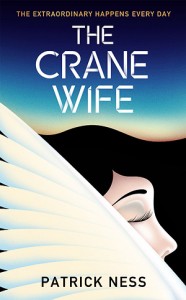The beginning: A man wakes up in the middle of the night and finds a wounded crane on his front lawn. Carefully, he extracts an arrow from its wing so that it can fly away. He tells it his name, George. The next day a woman called Kumiko enters his life, and everything changes.
The end (spoilers in this section only; highlight ’em if you want ’em): I predicted this correctly in my brain. I am not familiar with the story of the Crane Wife, but I feel like anyone who has ever read a fairy tale knew what was going to happen in the end of this story. Kumiko leaves/dies. The end does not specifically say so, but I am confident that this occurs as a result of George’s not being able to control his curiosity about her life apart from him.
The whole: First, a word about fairy tales. I have to tell you that I just absolutely love fairy tales. I love them so much. I love them to infinity. I love their unflinching rules. I love when the decisions of the magic in fairy tales are final, and I love when there are second chances. I love how people keep releasing new retellings of their favorite stories with beautiful, evocative illustrations in watercolor or woodcuts or pen and ink. But mainly I love how totally insane they are:
Not far off [the sausage] met with a dog on the road, who looking upon the sausage as lawful prey, had picked him up, and made an end of him. The bird then lodged a complaint against the dog as an open and flagrant robber, but it was all no good, as the dog declared that he had found forged letters upon the sausage, so that he deserved to lose his life.
Sure. Sometimes that’s the way it goes for a sentient sausage. Later in the story the mouse tries to use its body to stir the soup, the way the sausage always did, and it boils alive; and the bird drowns while trying to get water from the well. This is a real story from Grimm’s Fairy Tales.
The story of the Crane Wife, from Japan, has the man marrying the crane woman, and she makes very beautiful clothes, so beautiful that they sell for a lot of money and make the man and the crane women wealthy. The crane woman does all this on the condition that the man will never, ever come to watch her while she makes the clothes. But his curiosity (of course) gets the best of him, and he peeks in at her while she’s working. There he sees her transformed again into a crane and pulling out her own feathers to weave into the clothes. When she catches him looking, she flies away. (Cf. East of the Sun, West of the Moon; and the story of Cupid and Psyche; among many others.)
If I had a problem with The Crane Wife, it would be that Patrick Ness does not always quite succeed in blending the logic that fairy tales have (and her creations were so beautiful that every one who saw them fell into a sickness of yearning for them type thing)–which, again, I love and am perfectly willing to accept as part of a story–with the real-life elements. In some areas this does work. The sudden wild success of Kumiko’s tiles feels magical in the way fairy tale riches do, and George’s curiosity and desperation to know her is beautifully set up and played out.
The story works less well when dealing with George’s daughter, Amanda, and her life as a lonely single mother. It feels like Amanda’s part of a separate world, and for a while that was okay. Her story–encounters with the ex who dumped her, struggles to make friends with the unfriendly women at work, worrying about her kid–reminds you that even if George is living halfway in a fairy tale, everyone around him has to be part of the real world. But when Amanda’s story overlaps with Kumiko and gets a little more mystical and fairy-tale-ish, it feels contrived.
Have y’all read this yet? Any thoughts on what makes it not quite work? Or if you think it does work, any thoughts on why I’m wrong?


Cover report: American cover wins by a lot. Admittedly I am a sucker for art with houses in it, but even setting that aside, I just think the American cover is more visually interesting. I’d pick up the book based on the American cover, and I wouldn’t based on the British cover.
Note: I received this ebook from the publisher via Edelweiss, in exchange for an honest review.